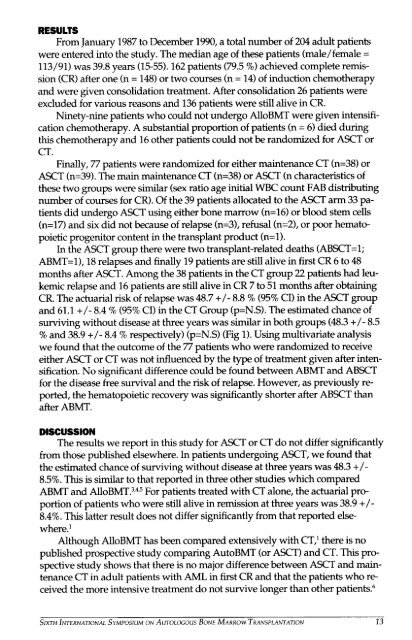VI Autologous Bone Marrow Transplantation.pdf - Blog Science ...
VI Autologous Bone Marrow Transplantation.pdf - Blog Science ...
VI Autologous Bone Marrow Transplantation.pdf - Blog Science ...
Create successful ePaper yourself
Turn your PDF publications into a flip-book with our unique Google optimized e-Paper software.
RESULTS<br />
From January 1987 to December 1990, a total number of 204 adult patients<br />
were entered into the study. The median age of these patients (male/female =<br />
113/91) was 39.8 years (15-55). 162 patients (79.5 %) achieved complete remission<br />
(CR) after one (n = 148) or two courses (n = 14) of induction chemotherapy<br />
and were given consolidation treatment. After consolidation 26 patients were<br />
excluded for various reasons and 136 patients were still alive in CR.<br />
Ninety-nine patients who could not undergo AlloBMT were given intensification<br />
chemotherapy. A substantial proportion of patients (n = 6) died during<br />
this chemotherapy and 16 other patients could not be randomized for ASCT or<br />
CT.<br />
Finally, 77 patients were randomized for either maintenance CT (n=38) or<br />
ASCT (n=39). The main maintenance CT (n=38) or ASCT (n characteristics of<br />
these two groups were similar (sex ratio age initial WBC count FAB distributing<br />
number of courses for CR). Of the 39 patients allocated to the ASCT arm 33 patients<br />
did undergo ASCT using either bone marrow (n=16) or blood stem cells<br />
(n=17) and six did not because of relapse (n=3), refusal (n=2), or poor hematopoietic<br />
progenitor content in the transplant product (n=l).<br />
In the ASCT group there were two transplant-related deaths (ABSCT=1;<br />
ABMT=1), 18 relapses and finally 19 patients are still alive in first CR 6 to 48<br />
months after ASCT. Among the 38 patients in the CT group 22 patients had leukemic<br />
relapse and 16 patients are still alive in CR 7 to 51 months after obtaining<br />
CR. The actuarial risk of relapse was 48.7 +/- 8.8 % (95% CI) in the ASCT group<br />
and 61.1 +/- 8.4 % (95% CI) in the CT Group (p=N.S). The estimated chance of<br />
surviving without disease at three years was similar in both groups (48.3 +/- 8.5<br />
% and 38.9 +/- 8.4 % respectively) (p=N.S) (Fig 1). Using multivariate analysis<br />
we found that the outcome of the 77 patients who were randomized to receive<br />
either ASCT or CT was not influenced by the type of treatment given after intensification.<br />
No significant difference could be found between ABMT and ABSCT<br />
for the disease free survival and the risk of relapse. However, as previously reported,<br />
the hematopoietic recovery was significantly shorter after ABSCT than<br />
after ABMT.<br />
DISCUSSION<br />
The results we report in this study for ASCT or CT do not differ significantly<br />
from those published elsewhere. In patients undergoing ASCT, we found that<br />
the estimated chance of surviving without disease at three years was 48.3 +/-<br />
8.5%. This is similar to that reported in three other studies which compared<br />
ABMT and AlloBMT. 3<br />
- 4<br />
' 5<br />
For patients treated with CT alone, the actuarial proportion<br />
of patients who were still alive in remission at three years was 38.9 +/-<br />
8.4%. This latter result does not differ significantly from that reported elsewhere.<br />
1<br />
Although AlloBMT has been compared extensively with CT, 1<br />
there is no<br />
published prospective study comparing AutoBMT (or ASCT) and CT. This prospective<br />
study shows that there is no major difference between ASCT and maintenance<br />
CT in adult patients with AML in first CR and that the patients who received<br />
the more intensive treatment do not survive longer than other patients. 6<br />
SIXTH INTERNATIONAL SYMPOSIUM ON AUTOLOGOUS BONE MARROW TRANSPLANTATION 13

















